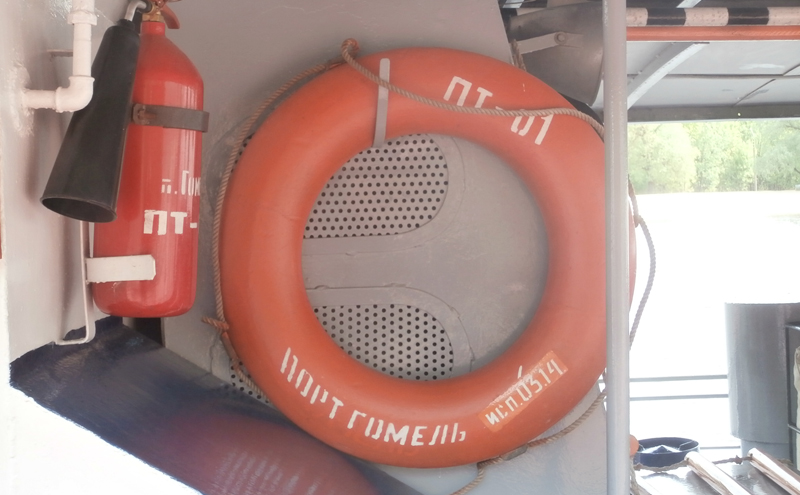If you’re a proud owner of a boat and want to maintain a high safety profile, you’ve probably asked yourself where you should keep a fire extinguisher handy.
However, it’s not as simple as just tossing one on board. To keep a safe environment on your boat at all times, you need to be more informed about the safety measures and some additional technicalities.
In this article, we’ve collected everything you need to know about where should fire extinguishers be stored on a boat.
Where Should Fire Extinguishers Be Stored on a Boat?
The first rule is to keep your fire extinguisher somewhere where it can be easily operated, and away from any place that makes it susceptible to damage.
It would be best to mount your extinguisher in an open space, making sure it’s standing upright at all times and readily accessible. You should also keep it in an obvious spot to remember inspecting it regularly.
This leads us to an important question: What are the obvious spots that a fire extinguisher can be kept at?
You could keep it in high-traffic areas where people are usually assembled at, and especially places with flammable materials are present.
The kitchen can be a smart place to store your fire extinguisher too. You can also keep inside the cabin, the bilge, or even the hull.
We need to emphasize that you should never store your extinguisher where it can be damaged.
You can ask yourself a few questions to narrow down your options of where to keep the fire extinguisher:
- Where do I keep flammable liquids or combustible materials on the boat?
- Where’s the boat’s kitchen or gallery? Is it a point of frequent traffic?
- Where do people spend most of their time on my boat?
- Where’s the gas tank located?
- How often is the boat cleaned of debris and garbage?
The Three-Foot Clearance Rule
It’s recommended that you keep a clearance area of three feet around the fire extinguisher. This is to avoid cluttering and ensure quick access in case of an emergency.
Mounting the Fire Extinguisher
Mounting your fire extinguisher is an easy process. You can usually do it in under five minutes using a simple holder and some basic guidelines.
You have to mount your extinguisher at an angle where the chemicals don’t settle at the bottom of its container.
Let’s say you decide to put your extinguisher in your kitchen. The first step is to buy a proper holder. Holders usually come with your fire extinguisher, and you can find one where you bought it if yours didn’t come with one (or you want to change it for some reason).
Everything is bound to move with the movement of the boat, making everything prone to displacement. This should never be the case for your fire extinguisher because it can either hurt one of the passengers or get lost in the water.
The next step is, of course, securing the fire extinguisher into its holder. This is done using an adequate number of brackets or mounts. Those act as belts and are available with the extinguishers. This is essential to prevent any unwanted accidents on the boat.
Is My Boat Required to Have a Fire Extinguisher?
Most likely, yes. All water vessels are required by law to have one Type B fire extinguisher on deck.
You qualify as a water vessel if you have an inboard engine or if your non-motorized vessel is longer than 26 feet. There are a lot of other conditions that make having a fire extinguisher onboard necessary.
Your boat may not be required to have a fire extinguisher by law. Yet, you should still consider having one for safety.
If your boat has any enclosed spaces or if you’re transporting flammable or combustible materials, it’s always better to keep an extinguisher at hand.
Here’s a great marine fire extinguisher:
Which Fire Extinguisher is Right for Me?
Extinguishers are classified according to the type of fire that they can put out with high efficiency.
Class A is made for solid combustible material, like wood, textiles, or paper.
Class B is made for combustible liquids. This is more suitable for kerosene, gasoline, oil, or even grease.
Class C is strictly for electrical fires. No other class will put out a fire nearly as efficiently as a Class C.
Class D is for fires that are made by flammable metals. This isn’t a common cause, and those fire extinguishers will usually not be needed on your boat.
Class K is sometimes found in boat kitchens. They’re made especially for fires that are made by cooking oil, grease, or animal/vegetable fats.
You’ll be ensuring maximum protection if you opt-in for a tri-classed fire extinguisher. This is an all-purpose extinguisher that’s made to take care of any fire that starts, whatever the source of it is.
Do I Need to Know Anything Else?
If you’re concerned with safety, you should consider enrolling in one of the boating safety classes offered across the United States. Those offer in-depth safety tips and instructions on how to get a safety certification or even a boating license.
The NFPA1 (National Fire Code) requires your fire extinguisher to be inspected every 30 days or less. They ask you to maintain and test it no less than once yearly. Moreover, you are asked to replace your extinguisher before 10 years after you’ve installed it.
To Sum Up
You now know everything related to fire extinguisher storage and some of the important technical information. We thought we’d remind you of the 4 basic steps in case of the unfortunate event of a fire.
You can memorize these steps using the word PASS.
- Pull the handle’s security pin
- Aim its nozzle or hose down and aim for the base.
- Squeeze the handle to discharge the extinguishing material
- Sweep the hose sideways to maintain full coverage of the fire


